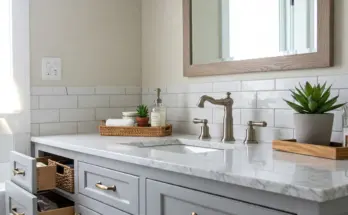Why Small Living Rooms Deserve Smart Design
Ever feel like your small living room is more cramped than cozy? You’re definitely not alone—we’ve all been there. Small spaces can be tricky, but they also have charm. With the right choices, comfort and space can absolutely go hand-in-hand.
Instead of cramming in more, we’ll focus on making the most of what we have. A few smart tweaks can transform everything. In this guide, we’ll explore clever layouts, cozy design touches, and space-saving furniture ideas that truly make a difference.
Let’s dive in and turn your small living room into the comfiest spot in the house!
Start with a Smart Layout
When working with a small living room, layout is everything. A thoughtful setup can instantly boost both comfort and function. Let’s break it down into a few simple steps.
Measure Before You Move
Before we start rearranging, we need to measure our space. It sounds basic, but it makes all the difference. With accurate measurements, we avoid buying furniture that overwhelms the room. Even better, we can plan a layout that truly fits. For example, knowing the wall length helps us center a couch or float it away from the wall if needed.
Define Zones
Even in a small space, it helps to create clear zones. This adds structure and makes the room feel intentional. We might have a lounging area for TV time, a reading nook by the window, or a small desk for work. By using rugs, lighting, or furniture placement, we can visually separate these areas without adding clutter.
Flow Matters
A cramped room is never comfortable, no matter how nice the furniture is. That’s why flow is so important. Let’s make sure there’s enough space to walk between pieces without squeezing through tight gaps. When in doubt, we should pull furniture away from the walls. Surprisingly, this often makes a small living room feel larger.
Avoid Overcrowding
We don’t need to fill every corner to make the space feel cozy. In fact, less is usually more. Too many pieces can make the room feel chaotic. Instead, let’s choose a few functional items we love. Leaving a bit of breathing room lets everything shine. Plus, it helps the room feel open and relaxed. By starting with a smart layout, we set the stage for a small living room that feels both comfortable and spacious.
Choose the Right Furniture
When it comes to furnishing a small living room, every piece needs to earn its place. We’re not just decorating—we’re problem-solving. The right furniture brings comfort, style, and function without overwhelming the space. Let’s look at how we can choose wisely.
Scale It Down
Oversized furniture may look inviting in a showroom, but it can swallow a small space whole. Instead, we need to choose pieces that match the proportions of our small living room. For example, a loveseat might fit better than a full-size sofa. Likewise, a round coffee table often works better than a large rectangular one. Smaller-scale furniture helps the room feel more open while still being completely functional.
Multipurpose Pieces
Why have furniture that only does one thing? When space is limited, multipurpose pieces are our best friends. We can use ottomans that double as storage or seating. A storage bench adds charm and hides clutter. Need a place to work? Try a fold-out desk that tucks away when not in use. These choices help us stay organized without sacrificing comfort.
Sleek Silhouettes
Bulky furniture can make a small living room feel boxed in. That’s where sleek, open-leg designs come in. By choosing pieces with clean lines and raised legs, we create a sense of airiness and movement. We’re also able to see more of the floor, which tricks the eye into thinking the room is bigger. Even something as simple as swapping a skirted sofa for one with legs can make a big difference.
Go Vertical
When floor space is limited, we look up. Vertical storage can work wonders in a small living room. Instead of wide, heavy bookcases or consoles, we opt for tall shelves or ladder-style units. They draw the eye upward, which adds visual height and keeps the floor more open. Plus, we gain extra storage without taking up precious walking space. With a few smart choices, we can furnish our small living room beautifully—without the clutter or the chaos.
Use Light and Color to Open Up the Room
In a small living room, light and color can completely change how the space feels. We don’t need a major renovation—just a few smart adjustments.
First, let’s talk about color. Soft, neutral shades like ivory, light gray, or pale beige instantly make a room feel more open. These tones reflect light better than dark colors, so everything feels brighter and more spacious. If we love color, we can still add it through accents like pillows or artwork.
Now let’s bring in the light. Natural light is gold, so let’s avoid blocking windows with heavy curtains. Instead, we can use sheer panels or light-filtering shades. But even with sunlight, artificial lighting makes a big difference. That’s why layered lighting is key. We combine ambient lighting (like overhead fixtures), task lighting (like reading lamps), and accent lighting (like wall sconces or LED strips). Each layer adds depth and warmth.
Finally, mirrors are our secret weapon. They reflect both light and space, doubling the visual size of a small living room. Placing a mirror across from a window can bounce light around the room beautifully. Even a mirrored tray or decorative piece can add a subtle boost.
With just a few simple updates, we can make our small living room feel light, open, and incredibly inviting.
Add Cozy Touches for Maximum Comfort
Soft layers instantly make a space feel warm and inviting. That’s why we love adding throw blankets, plush cushions, and textured rugs. A chunky knit throw on the couch or a shag rug underfoot adds softness without clutter. Even better, these items are easy to swap with the seasons.
Personal Style
To feel truly at home, our small living room should reflect who we are. We don’t need a gallery wall—just a few meaningful pieces. Whether it’s a framed photo, a piece of travel art, or a quirky décor item, it adds character. And yes, even small touches can make a big emotional impact.
Scent and Sound
Comfort isn’t just visual—it’s sensory. That’s why scent and sound matter more than we think. A softly scented candle or essential oil diffuser can create a calming vibe. Pair that with a small speaker playing soft music, and the mood is instantly set. These subtle additions turn a simple room into a relaxing retreat.
Warm Lighting
Lighting changes everything. Instead of harsh white bulbs, we can choose warm tones that feel soft and welcoming. We might use table lamps, string lights, or even dimmable bulbs to set the mood. Combined with cozy textures, it completes the vibe. With just a few thoughtful details, we can transform our small living room into a space that feels like a warm hug.
Declutter and Organize Like a Pro
In a small living room, clutter builds up fast—especially when we don’t have a place for everything. That’s why smart storage is key.
We can start by adding baskets or bins under the sofa for blankets, magazines, or remotes. These are easy to reach but stay out of sight. Vertical shelves are also great. They use wall space instead of floor space, which helps keep things tidy and stylish.
Next, let’s think about hidden helpers. Coffee tables with built-in storage can hold everything from games to coasters. Wall-mounted hooks work wonders too—they keep bags, headphones, or jackets off the floor.
Even better, these little upgrades don’t take up any extra room. But they make the space feel more open.
Finally, let’s keep surfaces clear. A cluttered table or crowded shelf makes even a spacious room feel cramped. By clearing off surfaces, we give the eye room to rest.
And when the room looks calm, it feels calm.
With just a few tweaks, we can keep our small living room organized, functional, and totally relaxing.
Design Tips That Make a Big Impact
In a small living room, the right design tricks can make a big impact without much effort or cost.
First, rugs are great for defining space. Even in an open area, a rug under the seating area makes everything feel grounded and intentional.
Next, let’s talk about curtains. By hanging them high—close to the ceiling—we draw the eye upward. This simple trick makes the walls look taller and the room feel more spacious.
We should also think about sightlines. Bulky items near eye level can make a room feel closed in. Instead, we keep things open by choosing lower furniture or wall art that doesn’t overwhelm the space.
Finally, materials matter. Glass or acrylic tables and shelves feel lighter than solid wood pieces. They take up less visual space, even if their size is the same.
These small choices can add up to a big change. With just a few tweaks, we can help our small living room feel more open, stylish, and comfortable.
Final Thoughts on Small Living Room
A small living room doesn’t mean giving up comfort—it just means getting creative. With smart layouts, cozy details, and clever furniture, we can make the most of every inch. Even simple changes like better lighting or thoughtful storage go a long way. Let’s not be afraid to experiment and find what feels right for us. After all, some of the coziest spaces come from working with what we’ve got.
Frequently Asked Questions (FAQ) Small Living Room
1. How can I make my small living room feel bigger? Use light colors, mirrors, and furniture with exposed legs. Keep clutter to a minimum and choose multi-functional pieces.
2. What type of furniture works best in a small living room? Opt for compact, multipurpose furniture like loveseats, storage ottomans, and nesting tables. Avoid oversized or bulky items.
3. Can I still have a cozy vibe in a small space? Absolutely! Add soft rugs, throw blankets, warm lighting, and personal touches like artwork or family photos for a cozy feel.
4. How should I arrange furniture in a small living room? Create a clear focal point, keep walkways open, and avoid pushing all furniture against the walls. Use rugs to define zones.
5. What colors work best for small living rooms? Light, neutral shades like soft gray, beige, or cream reflect light and open up the space. Add color with accents and decor.



